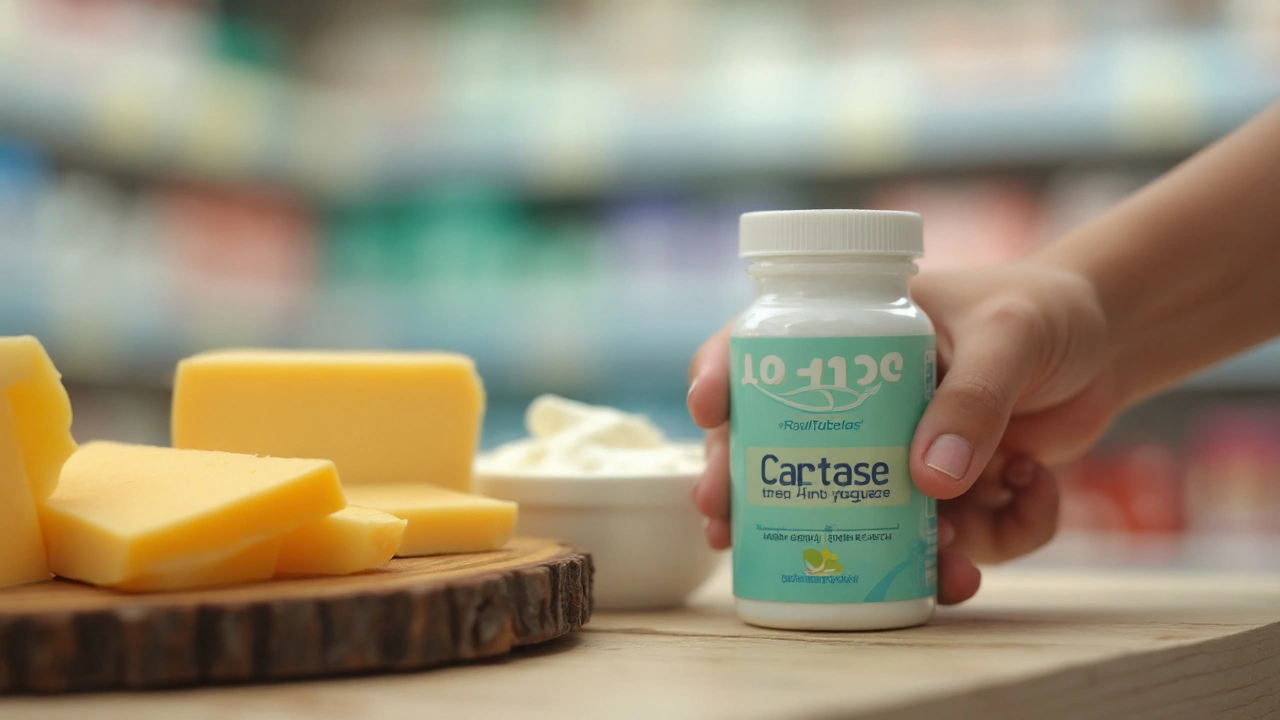 Sep, 22 2025
Sep, 22 2025
Lactase supplement is a dietary product that delivers the enzyme lactase (beta‑galactosidase) to aid the breakdown of lactose in the gastrointestinal tract. If you’ve ever dreaded a slice of cheese or a glass of milk, you already know why this tiny pill can feel like a game‑changer. Below you’ll learn the biology behind it, how to choose the right format, and real‑world tricks to make every dairy bite painless.
TL;DR - Quick Takeaways
- Lactase supplements contain beta‑galactosidase that cleaves lactose into glucose and galactose.
- Enteric‑coated tablets survive stomach acid and release the enzyme where it works best - the small intestine.
- Tablets, liquid drops, and chewables differ in dosage precision, speed of action, and convenience.
- Take the supplement right before dairy (5‑30 minutes) for maximum benefit.
- Side‑effects are rare; most users experience only mild stomach upset if they over‑dose.
The Biology of Lactose Digestion
To grasp why lactase supplements help, start with the natural process. In a healthy adult, the small intestine the long, winding part of the gut where most nutrient absorption occurs lines its inner surface with brush‑border enzymes, the most important of which for dairy lovers is lactase. This enzyme, scientifically called beta‑galactosidase a protein that hydrolyzes the disaccharide lactose into glucose and galactose, operates best at a pH of about 6.0‑6.5.
When lactase levels drop-whether genetically (primary lactose intolerance) or temporarily after gut infections (secondary intolerance)-the undigested lactose travels to the colon. There, gut bacteria ferment it, producing gas, bloating, and diarrhea. The core problem is not the dairy itself but the missing enzymatic step.
How a Supplement Replaces What’s Missing
Most lactase supplements are formulated to mimic the natural enzyme’s activity. They contain a measured amount of beta‑galactosidase, expressed in units (U) per tablet or per milliliter of drops. One unit equals the enzyme’s capacity to hydrolyze 1µmol of lactose per minute under optimal conditions.
When you swallow a tablet, the enzyme must survive the stomach’s acidic environment (pH≈1‑3). This is where enteric coating a protective polymer layer that resists dissolution in the stomach but breaks down in the higher pH of the intestine becomes crucial. Uncoated tablets can lose up to 80% of activity before reaching the small intestine, rendering them ineffective for many users.
Liquid drops are usually formulated without coating, relying on rapid transit; they’re best for people who take the dose immediately before a meal because the enzyme mixes directly with the food in the stomach. Chewables typically combine a mild coating with flavor, offering a balance between convenience and protection.
Comparing Common Formulations
| Form | Typical Dose (U) | Protection (Enteric) | Onset Speed | Best For |
|---|---|---|---|---|
| Tablet | 3,000‑9,000 | Yes (polymer shell) | 15‑30min | Planned meals, travel |
| Liquid Drops | 900‑1,800 per 5ml | No | 5‑10min | Immediate consumption, children |
| Chewable | 1,200‑2,400 | Partial (acid‑resistant matrix) | 10‑20min | On‑the‑go, those who dislike pills |
Choose the format that matches your lifestyle. If you’re a busy professional who packs a lunch, an enteric‑coated tablet taken 20minutes before you eat is the most reliable. If you’re a parent handing drops to a toddler, the rapid onset of liquid form makes sense, provided you give it right before the dairy food.
Dosage Guidelines Backed by Research
Clinical trials published by reputable nutrition institutes have shown a dose‑response curve: 3,000U can alleviate mild symptoms for up to 30g of lactose, while 9,000U covers 60‑80g. A 2022 double‑blind study involving 120 participants with self‑reported lactose intolerance reported a 78% reduction in abdominal pain when participants used a 6,000U tablet 15minutes before a 50g lactose challenge.
Guideline summary:
- Identify your typical lactose load (a cup of milk ≈ 12g, a slice of cheese ≈ 1g).
- Start with a low dose (3,000U for ≤20g lactose).
- If symptoms persist, double the dose on the next occasion.
- Do not exceed the manufacturer’s maximum daily recommendation (usually 30,000U) to avoid unnecessary gastrointestinal irritation.
Remember, the supplement’s job is to bridge the enzyme gap, not to replace a healthy gut microbiome. Pairing it with probiotic foods (yogurt with live cultures) can further support digestion.

Practical Tips for Maximising Effectiveness
- Timing is everything: Take the supplement 5‑30minutes before the first dairy bite. This allows the enzyme to mix with the food as it passes through the stomach.
- Watch the temperature: Enzyme activity drops sharply above 45°C. Hot coffee with a tablet may denature some of the lactase; let the beverage cool slightly.
- Store properly: Keep tablets in a cool, dry place. Moisture can activate the enteric coating prematurely.
- Adjust for fat content: High‑fat meals slow gastric emptying, giving the enzyme more time to work. You may need a slightly lower dose with a full‑fat cheese compared to skim milk.
- Know your limits: Even with supplements, extreme lactose loads (e.g., a gallon of ice‑cream) can overwhelm the enzyme capacity.
Safety, Side Effects, and Interactions
Lactase supplements are generally recognized as safe (GRAS) by food safety agencies. Reported side effects are mild and include:
- Transient bloating if the dose far exceeds your lactose load.
- Rare allergic reactions to filler ingredients (e.g., lactose‑free starch).
There are no known drug interactions, but antibiotics that disrupt gut flora may temporarily affect how your body processes dairy. If you’re on a strict low‑FODMAP diet for IBS, discuss supplement use with your dietitian, as the added enzyme can alter FODMAP calculations.
Regulation, Quality, and Choosing a Trusted Brand
In the UK, lactase supplements fall under the Food Supplements Regulations, overseen by the Food Standards Agency (FSA). Reputable manufacturers follow Good Manufacturing Practices (GMP) and provide batch‑specific certificates of analysis. Look for these quality markers:
- Clear unit labeling (U per serving).
- Third‑party testing results displayed on packaging or website.
- Enteric coating clearly stated for tablets.
Brands that have published peer‑reviewed studies or partnered with university nutrition departments tend to be more reliable. Avoid products that make vague “supports digestion” claims without dosage details.
Beyond Supplements: Lifestyle Strategies
Supplements are a handy tool, but long‑term management of lactose intolerance can include:
- Gradual exposure: Slowly increasing lactose intake can sometimes boost residual lactase activity.
- Fermented dairy: Yogurt and kefir contain live bacteria that partially pre‑digest lactose.
- Plant‑based alternatives: Almond, soy, and oat milks provide calcium without lactose.
Combining these habits with occasional lactase supplements lets you enjoy traditional dishes-think cheese board or tiramisu-without the dreaded after‑effects.
Next Steps in Your Digestive Journey
Now that you know the science, it’s time to experiment responsibly:
- Pick a reputable brand that lists unit dosage and enteric coating.
- Start with a low‑dose tablet before a modest dairy snack.
- Track symptoms in a simple diary (food, dose, reaction).
- Adjust dose or format based on the diary’s patterns.
Within a few weeks you’ll have a personalized plan that lets you reclaim the foods you love.

Frequently Asked Questions
What is the best time to take a lactase supplement?
Take it 5‑30 minutes before you start eating dairy. This ensures the enzyme mixes with the food as it moves through the stomach and reaches the small intestine where it works best.
Do I need an enteric‑coated tablet?
If you’re looking for consistent results, especially on an empty stomach, an enteric‑coated tablet is safest because it protects the enzyme from stomach acid. Liquid drops work too, but they must be taken right before the meal.
How many units of lactase should I take for a cup of milk?
A typical cup of milk contains about 12g of lactose. Most studies suggest 3,000U is enough to digest that amount without symptoms. If you’re highly sensitive, you might start with 4,500U.
Can lactase supplements cause side effects?
Side effects are rare. The most common issue is mild bloating if you take more enzyme than needed, because excess lactase can ferment in the colon. Allergic reactions to fillers are possible but uncommon.
Are there any drug interactions I should worry about?
Lactase is an enzyme, not a drug, so it doesn’t interact with medications. However, if you’re on antibiotics that disrupt gut bacteria, your overall digestion may change, so keep an eye on symptoms.
Do I need to keep a supplement on hand all the time?
It’s handy to have a small pack of tablets or a drop bottle in your bag or at work if you expect spontaneous dairy situations. For planned meals, a single dose is enough.
Tiffany Fox
September 22, 2025 AT 09:56I used to avoid cheese like it was poison. Now I eat it like it’s candy. Lactase tablets changed my life.
Rohini Paul
September 22, 2025 AT 21:38Interesting how the enzyme needs to survive stomach acid. I always thought the pill just magically worked. Turns out it’s science, not luck.
Courtney Mintenko
September 23, 2025 AT 10:13People treat lactase like a magic pill but nobody talks about how the real issue is our bodies evolved to stop making it. We’re just clinging to dairy like it’s a religion
Sean Goss
September 25, 2025 AT 07:02Let’s be real - most of these supplements are underdosed. The 3,000U recommendation is a joke if you’re consuming anything beyond skim milk. You need at least 10K U for real-world dairy loads. Also, enteric coating is non-negotiable - uncoated is just a placebo with a price tag.
Khamaile Shakeer
September 25, 2025 AT 18:09Wait… so I’ve been taking these wrong? 😳 I thought I could just crush them into my coffee… guess I’m doomed to bloat forever 🤡
Suryakant Godale
September 26, 2025 AT 08:47It is imperative to note that the enzymatic activity of beta-galactosidase is highly sensitive to pH fluctuations and thermal denaturation. One must therefore exercise caution regarding concurrent ingestion of thermally processed dairy products. Furthermore, the integrity of the enteric coating must be verified via third-party certification to ensure bioavailability.
John Kang
September 28, 2025 AT 07:54Start low, go slow. That’s the golden rule. I tried 9K U on my first try and ended up feeling like a balloon. 3K U did the trick. You don’t need to go hard.
Bob Stewart
September 28, 2025 AT 09:27Clarification: The enzyme unit definition is standardized by IUBMB as the amount required to hydrolyze one micromole of lactose per minute at 37°C and pH 6.5. Many commercial products misrepresent potency. Always verify the source of enzymatic activity data.
Simran Mishra
September 29, 2025 AT 15:11I’ve been lactose intolerant since I was 12. I tried everything. Probiotics, kefir, almond milk, even goat cheese - nothing worked. Then I found these tablets. I cried the first time I ate ice cream without pain. I didn’t think I’d ever get to enjoy dessert again. I still get anxious before eating dairy. What if it doesn’t work? What if I’m wrong? What if I’m just fooling myself? I’ve had panic attacks over cheese. I’m not exaggerating. I’ve cried over a slice of pizza. And now I’m just… scared to hope.
ka modesto
October 1, 2025 AT 05:29Pro tip: If you’re using drops, mix them into your milk or yogurt 10 minutes before drinking. Works like a charm. I do this for my kid’s cereal. No more morning tummy troubles.
Holly Lowe
October 2, 2025 AT 08:06Dairy without the drama? Yes please. I’m living my best life with a tablet in my purse and a cheese platter in my hand. Who needs a therapist when you’ve got lactase?
Cindy Burgess
October 2, 2025 AT 15:29While the article presents a comprehensive overview, it fails to address the potential for placebo effect in self-reported symptom reduction. Controlled studies often show diminished efficacy when blinding is properly implemented. Further research is warranted.
Tressie Mitchell
October 4, 2025 AT 02:06Of course you need enteric coating. Anyone who buys uncoated tablets is just throwing money away. This isn’t rocket science. It’s basic biochemistry. If you don’t know this, you shouldn’t be taking supplements at all.
dayana rincon
October 5, 2025 AT 00:54Me trying to take a pill before cheese 🤡 → me crying in the bathroom 2 hours later 🥲
Orion Rentals
October 5, 2025 AT 04:27The structural integrity of the enteric coating is paramount to the efficacy of the administered enzyme. I concur with the recommendation to prioritize products with third-party verification. This is a matter of clinical reliability.
Sondra Johnson
October 6, 2025 AT 05:48I used to think I hated cheese. Turns out I just hated feeling like my guts were staging a rebellion. Now I eat it with a smile. Lactase isn’t a crutch - it’s my freedom.